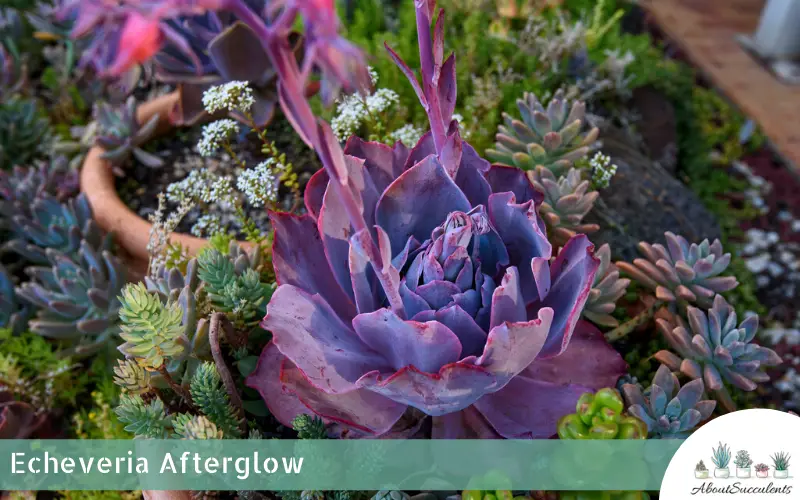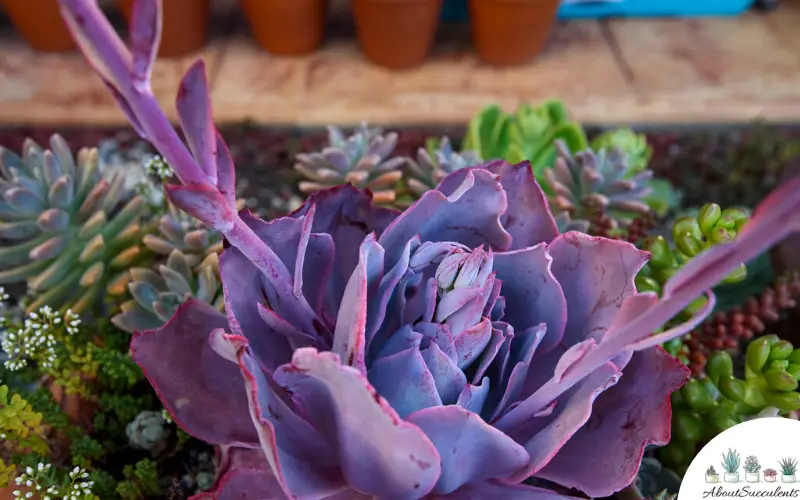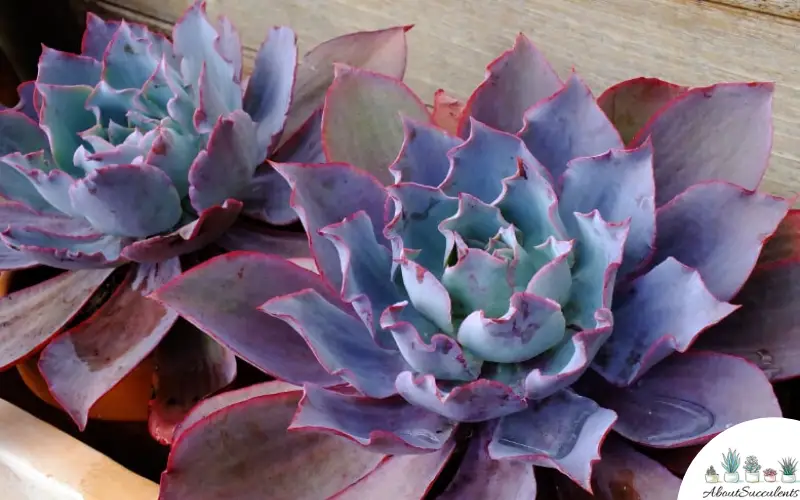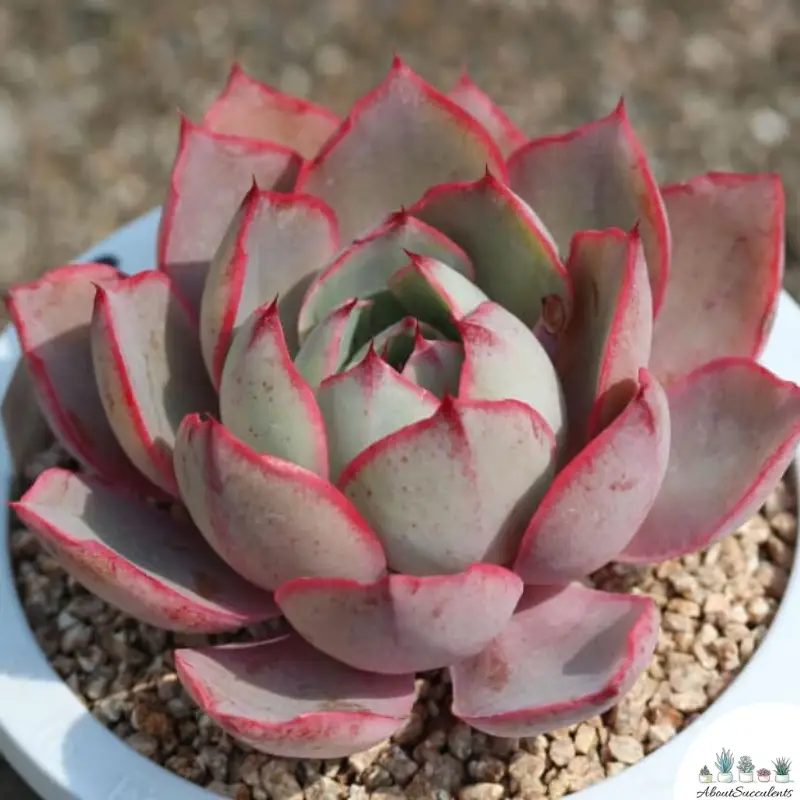
Echeveria Afterglow is an attractive and captivating succulent that is very easy to take care of. It forms a large blue-colored rosette that has bright pink coloring around the edges of the leaves. In the summertime, the succulent produces beautiful orange-red flowers that may emerge from its lower leaves.
The Echeveria Afterglow succulent plant is a hybrid between 2 other varieties of Echeverias. These varieties were the Echeveria Cante or White Cloud Echeveria and the Echeveria Shaviana or Mexican Hen.
White Cloud was the seed parent while Mexican Hen was the pollen parent. The hybrid experiment was performed by Don Worth, a professional photographer and succulent plant grower from San Francisco.
Afterglow can reach a height of 24-inches or 61cm. Another name that is given to this stunning succulent is “Mexican Hen and Chicks” because it produces offsets at the base of the mother plant.
Echeveria plants have been traced to the mountainous regions of northern Mexico and come from the Crassulaceae family.
General Information:
Also known as: Mexican Hen and Chicks
Plant Family: Crassulaceae
Origin: Hybrid creation of Don Worth from Echeveria Cante and the Echeveria Shaviana although the Echeveria variety are known to originate from the mountains of northern Mexico.
Height: 24-inches (61cm)
Exposure: Full to partial sunlight up to 6 hours per day
Water Needs: Water only when soil is dry to the touch, little watering during the winter months.
Soil Type: Cactus soil or soil mix made of potting soil with 50% to 75% coarse sand, pumice, and perlite.
Soil pH: Neutral (6.5 to 7.5 pH)
Tolerance: Drought
How to Grow and Care for Echeveria Afterglow

Echeveria Afterglow is one of the few succulent plants that can tolerate near-freezing temperatures for a short period of time. It is not a cold-hardy plant and thrives best in dry and warm regions.
If you live in a region where temperatures drop below 20° F (-6.7° C), it would be strongly advised to grow Afterglow indoors.
1. Sunlight
To achieve its full beauty, growers recommend that Echeveria Afterglow is grown outdoors where it can consistently receive sunlight.
Afterglow grows better when given partial to full sunlight.
Outdoors, plant Afterglow in an area in the garden that receives 6 hours of morning sunlight.
Indoors, place Afterglow near a window that brings in partial to full sunlight.

2. Watering
Echeveria Afterglow has similar watering needs as most succulents. It may grow better with fewer watering sessions than other plants.
The best way to know if Afterglow needs water is to check the moisture content of the soil.
All you have to do is touch the soil and see if it feels dry. To be certain, insert a stick 2 inches deep into the soil. If the stick feels dry, then it’s time to give the succulent water.
3. Pot and Soil
Pick a container that has a drainage hole to allow excess water to flow out. It must be large enough to enable the roots of Afterglow to grow freely without limiting airflow.
You can fill up the pot with a well-draining variety such as cactus or any commercial-available brand of potting soil that is made for succulents.
It is recommended to add 50% to 70% mineral grit to improve drainage. You can choose from perlite, pumice or coarse sand.
For a healthier Afterglow, give the succulent fertilizer during the summer months. Dilute the fertilizer to ¼ its original strength by adding water. Do not give fertilizer when the temperature starts to drop.
How to Propagate Echeveria Afterglow
Succulent hobbyists love Echeveria Afterglow because it is easy to propagate. There are 3 methods you can use to propagate this mesmerizing succulent plant in your garden: Offsets, cuttings, and leaves.

1. Offsets Method
Step 1 – Remove the offsets by using a sharpened and sterilized pair of garden shears or knife.
Step 2 – Place the offsets in a dry and warm area to allow them to harden or develop calluses.
Step 3 – After 1 or 2 days or when the offsets have callused, place them in a pot with well-draining soil.
2. Cuttings Method
Step 1 – Cut a stem from the main plant with a sharpened and sterilized knife or garden shears.
Step 2 – Leave the stem in a dry and shaded area to allow it to develop calluses.
Step 3 – If the stem has hardened enough, place it in a pot filled with well-draining soil.
Step 4 – Check the moisture level of the soil. If it is dry to the touch, give the plant water.
3. Leaves Method
Step 1 – Gently twist a leaf from the stem taking great care that there is no part leftover.
Step 2 – Allow the leaf to develop calluses.
Step 3 – Once the leaf has developed calluses place it in a pot that is filled with well-draining soil.
Frequently Asked Questions
Is Echeveria Afterglow Toxic for Cats and Dogs?
Echeveria Afterglow does not appear in the list of plants that are toxic to cats and dogs on the website of the American Society for the Prevention of Cruelty to Animals (ASPCA).
Why is my Echeveria Afterglow Succulent Dying?
If you suspect that your Echeveria Afterglow succulent plant is dying, there are 2 possible causes: Overwatering and pest infestation.
1. Overwatering
Overwatering Echeveria Afterglow will lead to root rot. If the roots of the plant start to rot, it will develop fungus that can spread to its other areas.
If you observe that parts of Afterglow are developing a brownish or blackish color that is evidence of root rot.
Immediately restrict the frequency of watering and cut off the infected part of the plant using a sterilized pair of garden shears. You can apply a fungicide to limit the growth of the fungus.
It would be a good idea to repot Afterglow. Gently remove the plant from the soil and allow the roots to thoroughly dry before transferring it to another pot with fresh potting soil.
2. Pest Infestation
Afterglow, like other members of the Echeveria variety, attracts pests such as mealybugs and aphids. These pests drink the sap of the plant and could deprive it of nutrition and hydration.
To keep pests away, remove dead leaves from the base of the plant. You can apply neem oil or an insecticide to get rid of them.
Mealybugs leave white, cotton-like substances on the plant. You can remove them by wiping with a piece of cotton that has been soaked in denatured alcohol.
Does Echeveria Afterglow Produce Flowers?
Yes, Echeveria Afterglow produced flowers in the summertime. The flowers have an orange-red color with bright edges that give it an ethereal look about it.
It is recommended to remove the flower stalk as it may interfere with the growth of Afterglow.
Last Updated on June 10, 2022 by Sofia Lara